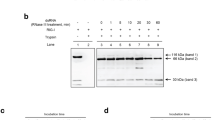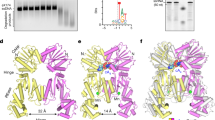Abstract
Retinoic-acid-inducible gene-I (RIG-I; also known as DDX58) is a cytoplasmic pathogen recognition receptor that recognizes pathogen-associated molecular pattern (PAMP) motifs to differentiate between viral and cellular RNAs. RIG-I is activated by blunt-ended double-stranded (ds)RNA with or without a 5′-triphosphate (ppp), by single-stranded RNA marked by a 5′-ppp1 and by polyuridine sequences2,3. Upon binding to such PAMP motifs, RIG-I initiates a signalling cascade that induces innate immune defences and inflammatory cytokines to establish an antiviral state. The RIG-I pathway is highly regulated and aberrant signalling leads to apoptosis, altered cell differentiation, inflammation, autoimmune diseases and cancer4,5. The helicase and repressor domains (RD) of RIG-I recognize dsRNA and 5′-ppp RNA to activate the two amino-terminal caspase recruitment domains (CARDs) for signalling. Here, to understand the synergy between the helicase and the RD for RNA binding, and the contribution of ATP hydrolysis to RIG-I activation, we determined the structure of human RIG-I helicase-RD in complex with dsRNA and an ATP analogue. The helicase-RD organizes into a ring around dsRNA, capping one end, while contacting both strands using previously uncharacterized motifs to recognize dsRNA. Small-angle X-ray scattering, limited proteolysis and differential scanning fluorimetry indicate that RIG-I is in an extended and flexible conformation that compacts upon binding RNA. These results provide a detailed view of the role of helicase in dsRNA recognition, the synergy between the RD and the helicase for RNA binding and the organization of full-length RIG-I bound to dsRNA, and provide evidence of a conformational change upon RNA binding. The RIG-I helicase-RD structure is consistent with dsRNA translocation without unwinding and cooperative binding to RNA. The structure yields unprecedented insight into innate immunity and has a broader impact on other areas of biology, including RNA interference and DNA repair, which utilize homologous helicase domains within DICER and FANCM.
This is a preview of subscription content, access via your institution
Access options
Subscribe to this journal
Receive 51 print issues and online access
$199.00 per year
only $3.90 per issue
Buy this article
- Purchase on Springer Link
- Instant access to full article PDF
Prices may be subject to local taxes which are calculated during checkout




Similar content being viewed by others
References
Schlee, M. et al. Approaching the RNA ligand for RIG-I? Immunol. Rev. 227, 66–74 (2009)
Saito, T., Owen, D. M., Jiang, F., Marcotrigiano, J. & Gale, M. Innate immunity induced by composition-dependent RIG-I recognition of hepatitis C virus RNA. Nature 454, 523–527 (2008)
Uzri, D. & Gehrke, L. Nucleotide sequences and modifications that determine RIG-I/RNA binding and signaling activities. J. Virol. 83, 4174–4184 (2009)
Matsumiya, T. & Stafforini, D. M. Function and regulation of retinoic acid-inducible gene-I. Crit. Rev. Immunol. 30, 489–513 (2010)
Chattopadhyay, S. et al. Viral apoptosis is induced by IRF-3-mediated activation of Bax. EMBO J. 29, 1762–1773 (2010)
Sun, Z., Ren, H., Liu, Y., Teeling, J. L. & Gu, J. Phosphorylation of RIG-I by casein kinase II inhibits its antiviral response. J. Virol. 85, 1036–1047 (2011)
Malathi, K., Dong, B., Gale, M., Jr & Silverman, R. H. Small self-RNA generated by RNase L amplifies antiviral innate immunity. Nature 448, 816–819 (2007)
Lu, C., Ranjith-Kumar, C. T., Hao, L., Kao, C. C. & Li, P. Crystal structure of RIG-I C-terminal domain bound to blunt-ended double-strand RNA without 5′ triphosphate. Nucleic Acids Res. 39, 1565–1575 (2011)
Lu, C. et al. The structural basis of 5′ triphosphate double-stranded RNA recognition by RIG-I C-terminal domain. Structure 18, 1032–1043 (2010)
Wang, Y. et al. Structural and functional insights into 5′-ppp RNA pattern recognition by the innate immune receptor RIG-I. Nature Struct. Mol. Biol. 17, 781–787 (2010)
Singleton, M. R., Dillingham, M. S. & Wigley, D. B. Structure and mechanism of helicases and nucleic acid translocases. Annu. Rev. Biochem. 76, 23–50 (2007)
Fairman-Williams, M. E., Guenther, U. P. & Jankowsky, E. SF1 and SF2 helicases: family matters. Curr. Opin. Struct. Biol. 20, 313–324 (2010)
Dürr, H., Korner, C., Muller, M., Hickmann, V. & Hopfner, K. P. X-ray structures of the Sulfolobus solfataricus SWI2/SNF2 ATPase core and its complex with DNA. Cell 121, 363–373 (2005)
Myong, S. et al. Cytosolic viral sensor RIG-I is a 5′-triphosphate-dependent translocase on double-stranded RNA. Science 323, 1070–1074 (2009)
Takahasi, K. et al. Nonself RNA-sensing mechanism of RIG-I helicase and activation of antiviral immune responses. Mol. Cell 29, 428–440 (2008)
Gu, M. & Rice, C. M. Three conformational snapshots of the hepatitis C virus NS3 helicase reveal a ratchet translocation mechanism. Proc. Natl Acad. Sci. USA 107, 521–528 (2009)
Lam, A. M., Keeney, D. & Frick, D. N. Two novel conserved motifs in the hepatitis C virus NS3 protein critical for helicase action. J. Biol. Chem. 278, 44514–44524 (2003)
Saito, T. et al. Regulation of innate antiviral defenses through a shared repressor domain in RIG-I and LGP2. Proc. Natl Acad. Sci. USA 104, 582–587 (2007)
Putnam, C. D., Hammel, M., Hura, G. L. & Tainer, J. A. X-ray solution scattering (SAXS) combined with crystallography and computation: defining accurate macromolecular structures, conformations and assemblies in solution. Q. Rev. Biophys. 40, 191–285 (2007)
Lorsch, J. R. & Herschlag, D. The DEAD box protein eIF4A. 2. A cycle of nucleotide and RNA-dependent conformational changes. Biochemistry 37, 2194–2206 (1998)
Polach, K. J. & Uhlenbeck, O. C. Cooperative binding of ATP and RNA substrates to the DEAD/H protein DbpA. Biochemistry 41, 3693–3702 (2002)
Theissen, B., Karow, A. R., Kohler, J., Gubaev, A. & Klostermeier, D. Cooperative binding of ATP and RNA induces a closed conformation in a DEAD box RNA helicase. Proc. Natl Acad. Sci. USA 105, 548–553 (2008)
Loo, Y. M. et al. Viral and therapeutic control of IFN-β promoter stimulator 1 during hepatitis C virus infection. Proc. Natl Acad. Sci. USA 103, 6001–6006 (2006)
Kawai, T. et al. IPS-1, an adaptor triggering RIG-I- and Mda5-mediated type I interferon induction. Nature Immunol. 6, 981–988 (2005)
Meylan, E. et al. Cardif is an adaptor protein in the RIG-I antiviral pathway and is targeted by hepatitis C virus. Nature 437, 1167–1172 (2005)
Seth, R. B., Sun, L., Ea, C. K. & Chen, Z. J. Identification and characterization of MAVS, a mitochondrial antiviral signaling protein that activates NF-κB and IRF 3. Cell 122, 669–682 (2005)
Xu, L. G. et al. VISA is an adapter protein required for virus-triggered IFN-β signaling. Mol. Cell 19, 727–740 (2005)
Gack, M. U. et al. TRIM25 RING-finger E3 ubiquitin ligase is essential for RIG-I-mediated antiviral activity. Nature 446, 916–920 (2007)
Binder, M. et al. Molecular mechanism of signal perception and integration by the innate immune sensor retinoic acid inducible gene-I (RIG-I). J. Biol. Chem. (2011)
Tang, G. Q., Bandwar, R. P. & Patel, S. S. Extended upstream A-T sequence increases T7 promoter strength. J. Biol. Chem. 280, 40707–40713 (2005)
Tang, G. Q., Bandwar, R. P. & Patel, S. S. Extended upstream A-T sequence increases T7 promoter strength. J. Biol. Chem. 280, 40707–40713 (2005)
Winn, M. D. et al. Overview of the CCP4 suite and current developments. Acta Crystallogr. D 67, 235–242 (2011)
Schneider, T. R. & Sheldrick, G. M. Substructure solution with SHELXD. Acta Crystallogr. D 58, 1772–1779 (2002)
Emsley, P. & Cowtan, K. Coot: model-building tools for molecular graphics. Acta Crystallogr. D 60, 2126–2132 (2004)
Adams, P. D. et al. PHENIX: a comprehensive Python-based system for macromolecular structure solution. Acta Crystallogr D 66, 213–221 (2010)
Konarev, P. V., Volkov, V. V., Sokolova, A. V., Koch, M. H. & Svergun, D. I. PRIMUS: a Windows PC-based system for small-angle scattering data analysis. J. Appl. Cryst. 36, 1277–1282 (2003)
Semenyuk, A. V. & Svergun, D. I. GNOM: a program package for small-angle scattering data processing. J. Appl. Cryst. 24, 537–540 (1991)
Svergun, D. I. Restoring low resolution structure of biological macromolecules from solution scattering using simulated annealing. Biophys. J. 76, 2879–2886 (1999)
Volkov, V. V. & Svergun, D. I. Uniqueness of ab initio shape determination in small-angle scattering. J. Appl. Cryst. 36, 860–864 (2003)
Petoukhov, M. V. & Svergun, D. I. Global rigid body modeling of macromolecular complexes against small-angle scattering data. Biophys. J. 89, 1237–1250 (2005)
Bernadó, P., Mylonas, E., Petoukhov, M. V., Blackledge, M. & Svergun, D. I. Structural characterization of flexible proteins using small-angle X-ray scattering. J. Am. Chem. Soc. 129, 5656–5664 (2007)
Niesen, F. H., Berglund, H. & Vedadi, M. The use of differential scanning fluorimetry to detect ligand interactions that promote protein stability. Nature Protocols 2, 2212–2221 (2007)
Acknowledgements
We acknowledge access to beamlines X29 at the NSLS (National Synchrotron Light Source), LRL-CAT at APS (Advanced Photon Source), and G1 and F1 at CHESS (Cornell High Energy Synchrotron Source) and thank the NSLS, APS and CHESS staff. NSLS and APS are supported by the US Department of Energy, Office of Science, Office of Basic Energy Sciences, under Contract No. DE-AC02-98CH10886 and DE-AC02-06CH11357, respectively. CHESS is supported by the NSF and NIH/NIGMS through NSF award DMR-0936384, and the MacCHESS resource is supported by NIH/NCRR award RR-01646. Use of the LRL-CAT beamline facilities at Sector 31 was provided by Eli Lilly & Company. We would like to thank V. Rajagopal for initiating the biochemical experiments and guiding the project in the early stages. We thank E. Arnold, H. Berman, S. K. Burley, R. Gillilian, L. Morisco, W. Olson, T. Saito, A. Shatkin, A. Stock, H. Yang and M. Zhuravieva for providing helpful comments and assistance. This work was supported by NIH grants GM55310 to S.S.P. and AI080659 to J.M.
Author information
Authors and Affiliations
Contributions
The project was initiated by M.G., J.M. and S.S.P. J.M. and S.S.P. designed and supervised the project. M.G. provided reagents and consultation. F.J. designed protein constructs and established purification protocols. A.R. generated all RNA reagents. F.J. and A.R. purified the complex and set up crystallization screens. F.J. optimized the crystal for data collection. J.M., M.T.M., F.J. and A.R. collected, processed and analysed the X-ray crystallographic data. M.T.M., F.J. and J.M. collected and analysed the SAXS data. A.R., G.-Q.T. and S.S.P. collected and analysed the RNA binding and ATPase assays. F.J. performed limited proteolysis and thermal melting assay. S.S.P. and J.M. wrote the paper and all authors contributed to editing.
Corresponding authors
Ethics declarations
Competing interests
The authors declare no competing financial interests.
Supplementary information
Supplementary Information
The file contains Supplementary Figures 1-6 with legends and Supplementary Tables 1-2. (PDF 3996 kb)
Rights and permissions
About this article
Cite this article
Jiang, F., Ramanathan, A., Miller, M. et al. Structural basis of RNA recognition and activation by innate immune receptor RIG-I. Nature 479, 423–427 (2011). https://doi.org/10.1038/nature10537
Received:
Accepted:
Published:
Issue Date:
DOI: https://doi.org/10.1038/nature10537
This article is cited by
-
Epigenetic addition of m5C to HBV transcripts promotes viral replication and evasion of innate antiviral responses
Cell Death & Disease (2024)
-
MAVS-loaded unanchored Lys63-linked polyubiquitin chains activate the RIG-I-MAVS signaling cascade
Cellular & Molecular Immunology (2023)
-
CD97 negatively regulates the innate immune response against RNA viruses by promoting RNF125-mediated RIG-I degradation
Cellular & Molecular Immunology (2023)
-
Retinoic acid-inducible gene 1 (RIG-1) and IFN-β promoter stimulator-1 (IPS-1) significantly down-regulated in the severe coronavirus disease 2019 (COVID-19)
Molecular Biology Reports (2023)
-
Recent advances in mRNA-LNP therapeutics: immunological and pharmacological aspects
Journal of Nanobiotechnology (2022)
Comments
By submitting a comment you agree to abide by our Terms and Community Guidelines. If you find something abusive or that does not comply with our terms or guidelines please flag it as inappropriate.



